NY Times: "The F.A.A. has no proof that electronic devices can harm a plane’s avionics, but it still perpetuates such claims" "Dealing with the F.A.A. on this topic is like arguing with a stubborn teenager"
Readers may recall that SpectrumTalk has repeatedly talked about the FAA’s renegade role in spectrum management: apparently not happy that Congress has split spectrum management between FCC and NTIA (with some international issues at State), FAA likes to impose itself as another coequal player in national spectrum management. Meanwhile NTIA for decades, glowing in its power derived from Section 305 of the Communications Act, has lacked the moral backbone and institutional authority to keep FAA in line with respect to national spectrum policy issues.
Recently the NY Times published the article whose heading is shown above. Here is a quote:
Dealing with the F.A.A. on this topic is like arguing with a stubborn teenager. The agency has no proof that electronic devices can harm a plane’s avionics, but it still perpetuates such claims, spreading irrational fear among millions of fliers.
A year ago, when I first asked Les Dorr, a spokesman for the F.A.A., why the rule existed, he said the agency was being cautious because there was no proof that device use was completely safe. He also said it was because passengers needed to pay attention during takeoff.
When I asked why I can read a printed book but not a digital one, the agency changed its reasoning. I was told by another F.A.A. representative that it was because an iPad or Kindle could put out enough electromagnetic emissions to disrupt the flight. Yet a few weeks later, the F.A.A. proudly announced that pilots could now use iPads in the cockpit instead of paper flight manuals.
Now FAA likes to say that the problem is “aggregation” - the impact of many emitters operating at the same time. But the real problem of aggregation comes from faulty technical analysis of the spectrum problems.
While aggregation can happen in some scenarios, e.g. terrestrial transmitters operating cochannel with a satellite uplink, real multipath propagation - as happens in most scenarios int he real world - results in lognormal propagation path losses in one or two emitters dominating the interference scenario and the others having no impact.
The Times points out that In December both FCC Chairman Genachowski and Senator Claire McCaskill (D-MO) both urged FAA to be more rational with respect to use of devices on aircraft. Sen. McCaskill even wrote that she was “prepared to pursue legislative solutions should progress be made too slowly.” She said she was urging the agency to embrace the use of electronics, including laptop computers, e-readers, smartphones and other devices, “during the full duration of a flight.”
“The current rules are inconvenient to travelers, don’t make sense and lack a scientific basis,” she said in the letter. “Airline employees have the incredibly important job of keeping us safe in the air. Their efforts are better spent worrying about rules that actually accomplish that goal.”
FAA likes to say that it is only obsessed with safety - an admirable goal if true. However, the sordid history of the FM/ILS affair also shows that FAA is just as concerned about the proprietary interests of “its constituency” - the airlines and AOPA - than it is of safety issues. Also the FAA’s bizarre 2006 NPRM, never coordinated with either FCC or NTIA, that proposed giving the agency veto power over both federal and nonfederal spectrum use in dozens of bands shows a fundamental misunderstanding of the public interest in spectrum.
So kudos to NY Times for their great coverage of this issue. When will NTIA and Congress pressure FAA to start acting more rationally on spectrum matters?
FCC Dismisses Complaint Related to OETB65C RF Safety Issue

On December 20, 2012 FCC, in the above action, dismissed a complaint by Ms. Cynthia Franklin under the obscure provisions of the Data Quality Act (“DQA”) - a 2001 piece of legislation your blogger had never heard of before.
Before getting into the details of Ms. Franklin’s complaint, let me point out that document is a reminder of a more general problem of the FCC website even after there recent improvements: Despite the huge amounts of (poorly organized) data on the FCC website, this complaint and the supporting document are nowhere to be found because it is a “undocketed” proceeding that also lacks any file number. Thus its very existence was unknown to the public until the 12/21 date of the above Order. Indeed even now there is no obvious way to see the whole text of the complaint short of filing a FOIA request and having FCC staff then quibble over whether they should charge you to see this information. Is this really “a government worthy of its people”?
(I also note that as of the drafting of this post, a search of the FCC website on “Cynthia Franklin” yields no results at all!)
OETB65C
Back to the specific issue of Ms. Franklin’s complaint, this deals with an issue that has been discussed here repeatedly since November 2010: OET Bulletin 65, Supplement C (“OETB65C”). This document has as a title, “Evaluating Compliance with FCC Guidelines for Human Exposure to Radiofrequency Electromagnetic Fields Additional Information for Evaluating Compliance of Mobile and Portable Devices with FCC Limits for Human Exposure to Radiofrequency Emissions”. This document describes its function as:
The purpose of this revised supplement is to provide parties filing applications for equipment authorization with guidance on complying with the latest requirements using up-to-date test procedures. This supplement is not intended, however, to establish mandatory procedures, and other methods and procedures may be acceptable if based on sound engineering practice.
Thus it is not a “regulation” because it is not “mandatory”, but it does give a “safe harbor” showing equipment authorization applications what FCC will accept for compliance showing with RF safety issues. As Time Magazine pointed out in 2010,
FCC testing regulations notably chose not to simulate a situation in which the phone was broadcasting at full power while inside a shirt or pants pocket flush against the body, an odd oversight given the known habits of many cellular-phone users.
OETB65C was issued in June 2001 and lists 2 authors and 3 contributors. (Only one of these people still work at FCC and I suspect he had little involvement with the controversy at hand.) Your blogger worked in OET management at the time and had absolutely no involvement. Indeed, OET was under acting leadership in the early Powell chairmanship at that time as Ed Thomas did not arrive as its chief until early 2002. As quoted in the FCC Order (remember, the actual compliant is still not on the public record due to the website problems mentioned above), the Franklin complaint deals “three of the FCC consumer documents” arguing that “the documents should be corrected to state that cell phones are not tested for RF exposure during use in direct contact with the body, and therefore they should not be used in such a manner.”
The December 20 Order reaffirms OET’s October 2011 rejection of the Ms. Franklin’s compliant - a document also not on the public record. The grounds seem to be a narrow interpretation of the Data Quality Act. Perhaps thee grounds are even a correct interpretation of the Data Quality Act.
Here is a sample of the FCC’s logic:
Ms. Franklin’s concerns, however, misconstrue the purpose of the document at issue, which is not to provide advice on how best to hold and use a cell phone, or to allow consumers to critique the sufficiency of testing methods, but rather to explain why a single reported maximum SAR value is an insufficient basis for comparing the likely RF exposure from individual cell phone models. Indeed, the guide emphasizes that SAR testing “does not indicate the amount of RF exposure consumers experience during normal use of the device.” And while Ms. Franklin asserts that the guide will encourage consumers to carry cell phones against their bodies, the only statement in the guide about how to carry a phone is quite to the contrary, noting that “the most effective means to reduce [RF] exposure are to hold the cell phone away from the head or body and to use a speakerphone or hands-free accessory.”
So basically the document at issue is not guidance to consumers, so it doesn’t matter if it is misleading! It is just guidance to cell phone manufacturers on how to avoid the intention of the FCC’s RF safety rules and there is no Data Quality Act issue involved in that under FCC’s logic.
Cell phone industry: If you want to gain the trust of the US public on RF safety issue you should not hide behind such charades. While your blogger believes that cell phones as actually used these days are safe, the sordid history of OETB65C does not reflect well on the cell phone industry and FCC’s objectivity on safety issues. Better transparency is needed in the drafting and implementation of FCC Rules on RF safety to keep the public trust.
FCC Operating Secret Hotels in Cambodia
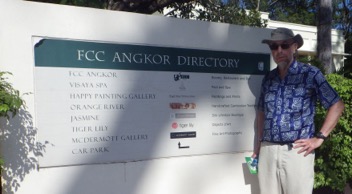
Several years ago a Japanese friend reported that FCC was secretly operating a hotel in Phnom Penh, Cambodia. Since SpectrumTalk believes in high journalistic standards, we did not report this until we could independently confirm it.

House Republicans have accused Chairman Genachowski of all sorts of alleged misdeeds, real or imagined. How could they have missed this blatant diversion of FCC assets?
NAB: "CA lawmakers to FCC: Protect viewers (from our members) during incentive auctions"
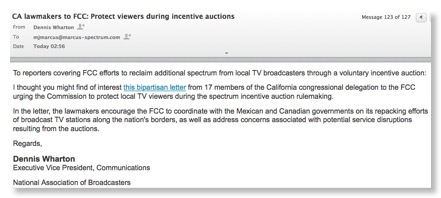
As part of its continuing disinformation campaign about the FCC’s incentive auction that was approved by Congress over NAB’s strenuous objection (impossible a decade ago when NAB was much more powerful at FCC and on the Hill - sic transit gloria mundi), NAB’s Dennis Wharton just sent out the above message. The message deals with a letter from California congressmen, no doubt instigated by NAB.
The letter basically says that the FCC incentive auction NPRM did not ask enough questions. For the record, the 189 page NPRM (not counting statements by commissioners) has 260 poorly organized questions.
(This is a general problem of FCC NPRMs and results from the internal coordination process where all sorts of people from the 8th Floor down can add questions or can be “bought off” with adding a question to silence some concern. I note that procurement requests for proposals (RFPs) by military agencies are as thick as NPRMs. ask for replies by outside parties, but have much better organized questions. However FCC is so insular and believing in its own exceptionalism that it has no interest to organize its questions better or to even number them!)
So will the NAB disinformation campaign continue? Of course just as NAB’s first response to Hurricane Sandy was not to brag, rightfully, about broadcaster performance during the storm but rather “dis” the cellular industry. Below are some recent NAB tweets from @AirWharton on their ongoing battle with the cellular industry.
Note that NAB has been so technically unsavvy and behind the times that they use @AirWharton on Twitter because they don’t have any Twitter accounts using “NAB”, which belongs to National Australia Bank, whereas the more technically savvy and up to date CTIA certainly has @CTIA.
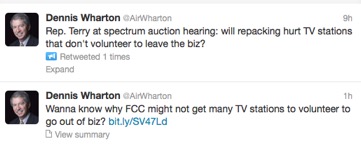
"Michael Marcus, P.I." - FHH Current Issues in Telecommunications Law and Regulation

My friends at FHH CommLawBlog have written the above article in the December 2012 Current Issues in Telecommunications Law and Regulation, a newsletter based on the blog. (Apparently FHH has a law practice as a sideline to blogging. Blogging is really a lot more fun!)
The article deals with my FOIA request at FCC to get to the bottom of the U-NII interference to safety-related NOAA TDWR weather radars near airports. This resulted in a “reverse FOIA” action by Motorola seeking to limit the release of information for what was said to be protection of proprietary information but which appeared to be based in some part on just preventing embarrassment.
Original Motorola Redaction Initially Upheld by FCC Staff

Redaction After FCC 9/12 Order
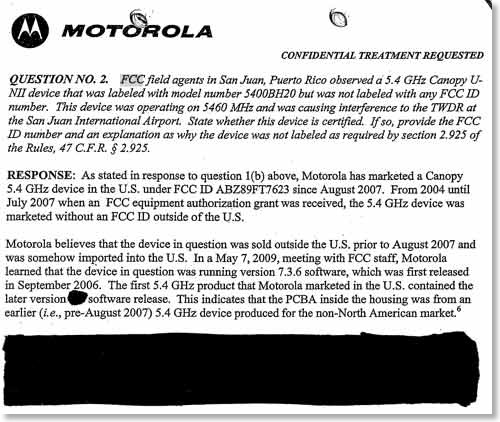
FCC ultimately upheld part of your blogger’s request giving Motorola the type of defeat that used to be very rare for them when they dominated (monopolized?) the mobile radio biz.
Here’s part of what FHH wrote:
In our recent blog post on our CommLawBlog site about an AT&T wireless Internet service causing interference to an airport weather radar in Puerto Rico, we asked whether the FCC had charged AT&T with the wrong offense. Because the transmitter operated outside its FCC- certified frequency range (among other problems), the FCC determined it did not qualify for unlicensed operation, and so fined AT&T for not having a license – even though AT&T could not have obtained a license for that service.
Our friend Michael Marcus, a spectrum-savvy engineer (and former FCC official), asked a different question: how did the transmitter get to be operating on a non-certified frequency? Where most of us would be content to mull this over in our idle hours (if it occurred to us at all), Marcus is made of different stuff. He not only took the question to the highest reaches of the FCC, but managed to get some answers.
The article goes on to say
Marcus appealed that decision to the full Commission, ask- ing for access to specific redacted information. He argued, in part, that release of the information is in the public interest because it may shed light on the root causes of interference from the Canopy transmitters into airport radars, and thus promote air safety. The FCC’s decision gave Marcus a partial victory.
Thanks to FHH for the free press.

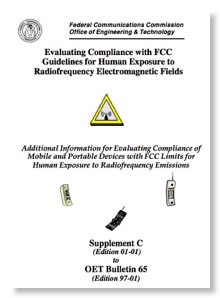



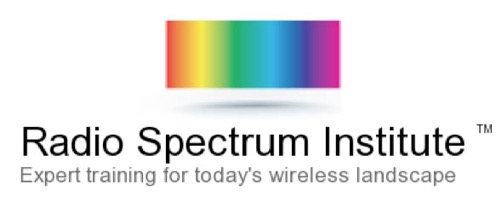


![Validate my RSS feed [Valid RSS]](valid-rss-rogers.png)

